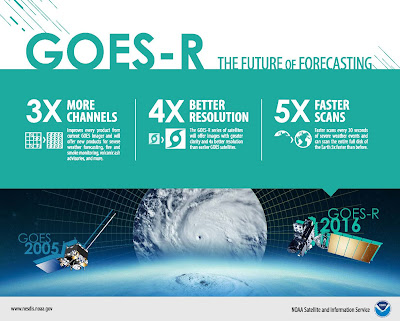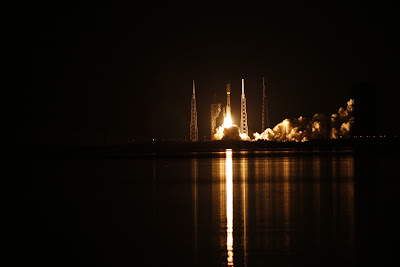On November 19th at 6:42 p.m. EDT ( 11:42 p.m. UTC ) United launch Alliance (ULA) Atlas V - 541 configuration rocket lifted off at the end of the launch window which started at 5:42 p.m. EDT ( 10:42 p.m. UTC ) from SLC- 41 Cape Canaveral Airforce Station carrying the National Oceanic and Atmospheric Administration or NOAA Geostationary Operational Environmental Satellite R series or GOES-R, since the successful launch and deployment has been renamed to GOES-16.
What was initially slated as a pre-dusk launch turned into a night launch due to unspecified reasons on officially reported as booster anomaly that was fixed and then in succession an unspecified range anomaly. Now these were never confirmed by United launch Alliance. But The Weather Channel reported that it was an errant boat that drifted into the red zone or no-go Zone off the coast which is the flight path of the Atlas V booster after liftoff.
(Credit: Lockheed Martin) GOES-R rendering
The GOES-R satellite built by Lockheed Martin and this satellite has six instruments that fit into three different classifications. The first being Earth pointing, the second is Solar Pointing and the third In-SITU (near environment). Lockheed Martin is providing three instruments which are the Solar Ultraviolet Imager (SUI) the Geostationary Lightning Mapper (GLM) and the Magnetometer.
Three additional instruments including will be Advanced Baseline Imager (ABI) developed by the Harris Corporation, the Extreme Ultraviolet X-ray Irradiance Sensors (EXISS) from the University of Colorado's laboratory for Atmospheric and Space physics and finally the Space Environmental In-SITU Suite (SEISS) from the Assurance Technology Corporation.
The GOES-R series of satellites is a joint effort between NOAA - National Oceanic and Atmospheric Administration and NASA - National Aeronautics and Space Administration to develop, launch and successfully operate the GOES series of satellites. These satellites have played a pivotal role in weather forecasting, severe storm tracking and important meteorological research since the first GOES was launched on a Delta rocket in 1975 some 41 years ago. United Launch Alliance's Atlas and Delta series of rockets have launched every spacecraft in the GOES series.
(Credit: NOAA) GOES-R Info-graphic
The rocket is the second most powerful in the Atlas V 500 series the first being the Atlas V 551. This launch vehicle will have the common core booster powered by two RD-180 engines provided by NPO Energomash. And the Centaur upper stage powered by Aerojet / Rocketdyne's RL-10A and will have 4 Solid Rocket Boosters for extra lift power. Below are photos taken by me during the last 2 days events from the Media Viewing for Roll Out to SLC-41 to the launch on the 18th and then the spectacular launch on the 19 of November at 6:42 p.m. EDT (11:42 p.m. UTC).
(Credit: 2016 Keltisch Wolf Media) ULA Atlas V - 541 GOES-R SLC-41 Rollout
(Credit: 2016 Keltisch Wolf Media) ULA Atlas V - 541 GOES-R SLC-41 T-22 hours+
(Credit: 2016 Keltisch Wolf Media) ULA Atlas V - 541 GOES-R SLC-41 T-22 hours+ @ 50 yards
(Credit: 2016 Keltisch Wolf Media) ULA Atlas V - 541 GOES-R SLC-41 Off Gassing
(Credit: 2016 Keltisch Wolf Media) ULA Atlas V - 541 SLC-41 RD-180 ignition GOES-R T-0
(Credit: 2016 Keltisch Wolf Media) ULA Atlas V - 541 GOES-R T+5
(Credit: 2016 Keltisch Wolf Media) ULA Atlas V - 541 GOES-R T+8











Don't give up. Write more!
ReplyDelete